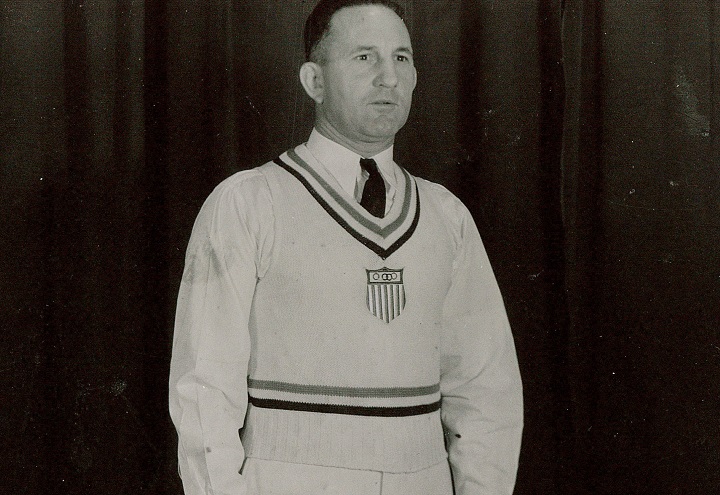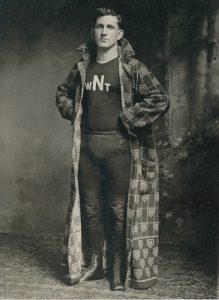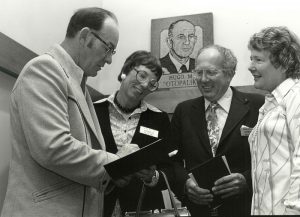
Otopalik Was Wrestler, Coach, Organizer, Booster
Reprinted from The History of Collegiate Wrestling: A Century of Wrestling Excellence
By Don Sayenga and Jairus K. Hammond
Hugo Otopalik, a Distinguished Member inducted into the National Wrestling Hall of Fame in the Charter Class of 1976, was the first collegiate wrestling star to go on to become a great collegiate coach.
 At the age of 25, he played in the backfield of the fabulous 1915 Nebraska football team, the first undefeated Cornhusker team. He and fellow back Dick Rutherford also carried superstar status when they appeared on the mats for Dr. Raymond Clapp’s wrestling squad.
At the age of 25, he played in the backfield of the fabulous 1915 Nebraska football team, the first undefeated Cornhusker team. He and fellow back Dick Rutherford also carried superstar status when they appeared on the mats for Dr. Raymond Clapp’s wrestling squad.
Clapp, a Distinguished Member also inducted in 1976, had been an outstanding athlete at Yale a dozen years earlier, becoming the first man in history to pole vault more than 10 feet. The mark he set at just below 12 feet in 1898 stood for many years.
Clapp held a medical degree and at Nebraska was particularly interested in adding wrestling to the gymnasium curriculum. He arranged to host the Big Ten open meet or “Westerns” in 1915, the only time it was ever held by a non-Conference school, and his Huskers carried off team honors that year. Rutherford won a title that year, and in 1916 both he and Otopalik were wrestling champions of the Westerns. When Otopalik repeated as champion in 1917, the Iowa student newspaper actually criticized him for merely winning. “This match was the roughest of the day,” it carped, “and Wiley of Indiana proved himself almost as adept at roughing it as Otopalik.”
After graduating from Nebraska, Otopalik was immediately hired as athletic director at Kearney State Teachers College. Meanwhile, Iowa State was looking for an assistant in physical education. Because Dr. Clapp and ISU Athletic Director Charley Mayser, a Distinguished Member inducted in 1977, had been students together at Yale, Clapp strongly recommended Otopalik for the position. Otopalik moved to Ames in 1920 and helped Mayser mold the strong Cyclone wrestling squads of the early ’20s. When Mayser returned to Franklin & Marshall in 1923, Otopalik was asked to take over the coaching reins of the wrestling team until a permanent coach could be located. Otopalik continued in this role for the next 30 years.
 He immediately distinguished himself in the organization of the 1924 Olympic trials and attracted the attention of Bill Streit, then AAU chairman, who arranged for Iowa State to become the site of the 1927 AAU tournament. Two Iowa State team members, Ralph Prunty and Art Holding, inducted into the Glen Brand Wrestling Hall of Fame of Iowa in 2016, won national titles at this meet. However, the biggest impact of the tournament was the highly successful and efficient way in which Otopalik organized it. The almost 150 entries, 95 percent of which were college students, made it the largest such tourney to that date.
He immediately distinguished himself in the organization of the 1924 Olympic trials and attracted the attention of Bill Streit, then AAU chairman, who arranged for Iowa State to become the site of the 1927 AAU tournament. Two Iowa State team members, Ralph Prunty and Art Holding, inducted into the Glen Brand Wrestling Hall of Fame of Iowa in 2016, won national titles at this meet. However, the biggest impact of the tournament was the highly successful and efficient way in which Otopalik organized it. The almost 150 entries, 95 percent of which were college students, made it the largest such tourney to that date.
“These figures brought very forcibly to the NCAA Wrestling Committee the desirability of a national intercollegiate meet that wrestlers might find competition with other college men and not be forced to compete with men of non–college groups,” Otopalik wrote.
Consequently, when Dr. Clapp, as secretary, proposed that the committee immediately arrange for such a meet, the first NCAA championships were scheduled for Ames in 1928. Holding won a title for Iowa State and then joined Prunty as a member of the Amsterdam Olympic team.
During the 1930s, Iowa State continued its reputation of winning, which continues through to the present day. ISU had at least one NCAA champ from 1930 through 1933, including Hugh Linn, Dick Cole, Merrill Frevert, and Bob Hess. In 1933 the Cyclones tied Oklahoma State for unofficial team honors, and one of the champs, George Martin, a Distinguished Member inducted in 1982, went on to coach at Wisconsin.
 Otopalik also started grade school and junior high wrestling championship at Ames and helped establish the Big Six Conference. Hess was selected for the 1932 Olympic team, and Otopalik was the head coach at Los Angeles. After World War II broke out, Iowa State was one of the few schools that kept its wrestling program alive until 1943, when Otopalik departed to serve with the Red Cross in the European theater.
Otopalik also started grade school and junior high wrestling championship at Ames and helped establish the Big Six Conference. Hess was selected for the 1932 Olympic team, and Otopalik was the head coach at Los Angeles. After World War II broke out, Iowa State was one of the few schools that kept its wrestling program alive until 1943, when Otopalik departed to serve with the Red Cross in the European theater.
After World War II he became very active in AAU affairs. He served five times as national chairman and eventually became vice president of the FILA. He fell ill just after the 1953 NCAA meet and died later that year. He finished with a dual meet record of 159-66-5. Otopalik staged the final Olympic team trials in 1948 and 1952, and one of his wrestlers, Glen Brand, won an Olympic gold medal in 1948.
However, it is his skill as an organizer and booster for which Otopalik is best remembered.
In 1930 he wrote: “My contention is this, that if any individual sport ever rises to dominate the team sports in popularity, that sport will be wrestling.”
The History of Collegiate Wrestling: A Century of Wrestling Excellence is a "must have" for every college wrestling fan that allows readers to experience and relive the glory of college wrestling through stunning photographs and timeless stories. CLICK HERE to order your copy
By Don Sayenga and Jairus K. Hammond
Hugo Otopalik, a Distinguished Member inducted into the National Wrestling Hall of Fame in the Charter Class of 1976, was the first collegiate wrestling star to go on to become a great collegiate coach.
 At the age of 25, he played in the backfield of the fabulous 1915 Nebraska football team, the first undefeated Cornhusker team. He and fellow back Dick Rutherford also carried superstar status when they appeared on the mats for Dr. Raymond Clapp’s wrestling squad.
At the age of 25, he played in the backfield of the fabulous 1915 Nebraska football team, the first undefeated Cornhusker team. He and fellow back Dick Rutherford also carried superstar status when they appeared on the mats for Dr. Raymond Clapp’s wrestling squad.Clapp, a Distinguished Member also inducted in 1976, had been an outstanding athlete at Yale a dozen years earlier, becoming the first man in history to pole vault more than 10 feet. The mark he set at just below 12 feet in 1898 stood for many years.
Clapp held a medical degree and at Nebraska was particularly interested in adding wrestling to the gymnasium curriculum. He arranged to host the Big Ten open meet or “Westerns” in 1915, the only time it was ever held by a non-Conference school, and his Huskers carried off team honors that year. Rutherford won a title that year, and in 1916 both he and Otopalik were wrestling champions of the Westerns. When Otopalik repeated as champion in 1917, the Iowa student newspaper actually criticized him for merely winning. “This match was the roughest of the day,” it carped, “and Wiley of Indiana proved himself almost as adept at roughing it as Otopalik.”
After graduating from Nebraska, Otopalik was immediately hired as athletic director at Kearney State Teachers College. Meanwhile, Iowa State was looking for an assistant in physical education. Because Dr. Clapp and ISU Athletic Director Charley Mayser, a Distinguished Member inducted in 1977, had been students together at Yale, Clapp strongly recommended Otopalik for the position. Otopalik moved to Ames in 1920 and helped Mayser mold the strong Cyclone wrestling squads of the early ’20s. When Mayser returned to Franklin & Marshall in 1923, Otopalik was asked to take over the coaching reins of the wrestling team until a permanent coach could be located. Otopalik continued in this role for the next 30 years.
 He immediately distinguished himself in the organization of the 1924 Olympic trials and attracted the attention of Bill Streit, then AAU chairman, who arranged for Iowa State to become the site of the 1927 AAU tournament. Two Iowa State team members, Ralph Prunty and Art Holding, inducted into the Glen Brand Wrestling Hall of Fame of Iowa in 2016, won national titles at this meet. However, the biggest impact of the tournament was the highly successful and efficient way in which Otopalik organized it. The almost 150 entries, 95 percent of which were college students, made it the largest such tourney to that date.
He immediately distinguished himself in the organization of the 1924 Olympic trials and attracted the attention of Bill Streit, then AAU chairman, who arranged for Iowa State to become the site of the 1927 AAU tournament. Two Iowa State team members, Ralph Prunty and Art Holding, inducted into the Glen Brand Wrestling Hall of Fame of Iowa in 2016, won national titles at this meet. However, the biggest impact of the tournament was the highly successful and efficient way in which Otopalik organized it. The almost 150 entries, 95 percent of which were college students, made it the largest such tourney to that date.“These figures brought very forcibly to the NCAA Wrestling Committee the desirability of a national intercollegiate meet that wrestlers might find competition with other college men and not be forced to compete with men of non–college groups,” Otopalik wrote.
Consequently, when Dr. Clapp, as secretary, proposed that the committee immediately arrange for such a meet, the first NCAA championships were scheduled for Ames in 1928. Holding won a title for Iowa State and then joined Prunty as a member of the Amsterdam Olympic team.
During the 1930s, Iowa State continued its reputation of winning, which continues through to the present day. ISU had at least one NCAA champ from 1930 through 1933, including Hugh Linn, Dick Cole, Merrill Frevert, and Bob Hess. In 1933 the Cyclones tied Oklahoma State for unofficial team honors, and one of the champs, George Martin, a Distinguished Member inducted in 1982, went on to coach at Wisconsin.
 Otopalik also started grade school and junior high wrestling championship at Ames and helped establish the Big Six Conference. Hess was selected for the 1932 Olympic team, and Otopalik was the head coach at Los Angeles. After World War II broke out, Iowa State was one of the few schools that kept its wrestling program alive until 1943, when Otopalik departed to serve with the Red Cross in the European theater.
Otopalik also started grade school and junior high wrestling championship at Ames and helped establish the Big Six Conference. Hess was selected for the 1932 Olympic team, and Otopalik was the head coach at Los Angeles. After World War II broke out, Iowa State was one of the few schools that kept its wrestling program alive until 1943, when Otopalik departed to serve with the Red Cross in the European theater.After World War II he became very active in AAU affairs. He served five times as national chairman and eventually became vice president of the FILA. He fell ill just after the 1953 NCAA meet and died later that year. He finished with a dual meet record of 159-66-5. Otopalik staged the final Olympic team trials in 1948 and 1952, and one of his wrestlers, Glen Brand, won an Olympic gold medal in 1948.
However, it is his skill as an organizer and booster for which Otopalik is best remembered.
In 1930 he wrote: “My contention is this, that if any individual sport ever rises to dominate the team sports in popularity, that sport will be wrestling.”
The History of Collegiate Wrestling: A Century of Wrestling Excellence is a "must have" for every college wrestling fan that allows readers to experience and relive the glory of college wrestling through stunning photographs and timeless stories. CLICK HERE to order your copy